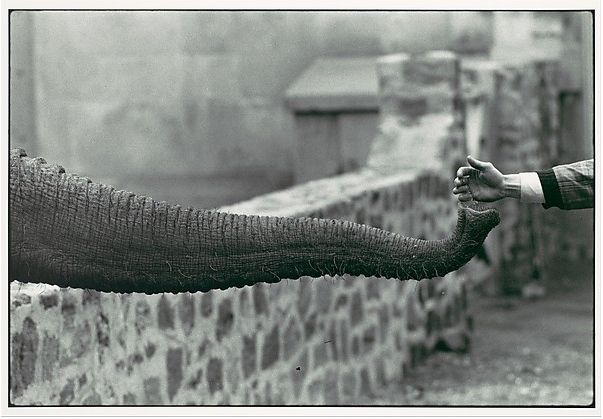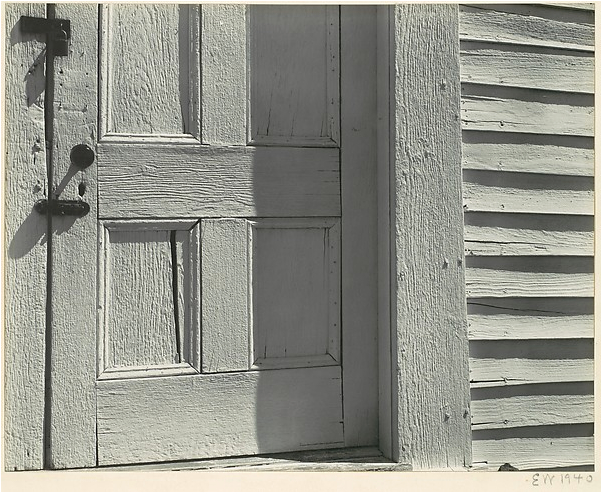If we restrict ourselves to the perspectives of philosophers such as Barthes, Sontag or Berger our reading of photography runs the risk of becoming formulaic where we stop looking at the photograph in our concentrated search for the signs or socio-political messages it contains. It is important to balance these external viewpoints by also reading photography on its own terms and in its own language. My research led me to three books which look at photography quite differently.
John Szarkowski, the one time curator of photography at the MoMA, includes a set of photographs in his book The Photographer’s Eye (1) that he says have little in common other than a shared vocabulary that belongs only to photography. Szarkowski’s vocabulary is deceptively simple and not over explained by his text but the collection of photographs included in each group offer plenty of opportunity to explore his ideas.
The second viewpoint is offered by Stephen Shore, an acclaimed photographer and established educator in The Nature of Photographs (2). If Szarkowski, the curator, is economical with his words Shore, the professor, is miserly; this is a book that dissects photography with terse statements and an eclectic selection of images. It has the feeling of being notes from a lecture but is none the worse for that.
The third perspective is from someone outside of the world of photography which meant that I approached this book with some reservations but Geoff Dyer’s The Ongoing Moment (3) approaches the subject from a fresh and methodically researched direction so his declaration that he doesn’t even own a camera is a point soon forgotten or forgiven. This book is the antidote to Szarkowski and Shore’s brevity with each of Dyer’s ideas explained in great depth.
Despite the diverse nature of their backgrounds these three men have a common approach, one that is based on looking at photographs in the round, as a complete object that inspires or intrigues the author.
John Szarkowski – The Photographer’s Eye
Szarkowski makes no attempt to categorise the photographs he selects, no does he reference the visual artists that predate photography, he sees photography as a self contained art that has created its own traditions and in doing so its own vocabulary. He starting point is to attempt to define five characteristics that whilst not unique in themselves come together in a unique manner to define the nature of photography.
There is some crossover with Jonathan Bayer (4) (see here) but despite predating the Reading Photographs exhibition (i) by thirteen years there is a more crisp and fresher feel to Szarkowski’s writings than Bayer. This is helped by the higher production quality of the MoMA book.
The Thing Itself
“The subject and the picture were not the same thing, although they would afterwards seem so.” (1) Szarkowski argues that the successful photographer recognises that photography has a inseparable relationship with the reality that surrounds us, a reality that provides an endless array of wondrous things and important moments. The photographer’s skill is to see beyond the reality and find the “still invisible” picture and that it is this relationship between reality, the photographer and the picture that is unique to photography. This idea is discussed much later by David Campbell (5) who tells us that “events are not found objects” waiting to be discovered, “they have to be constructed”. This is one of photography’s great abilities, it captures a moment that in real time is hardly recognisable and in capturing that moment it creates an event. Connect many such moments and it is possible to construct complex narratives that define broader events, an idea that leads us to Allen Feldman’s (6) argument that “the event is not what happens. The event is that which can be narrated.”
Szarkowski’s point is that the photographer sees the invisible picture and by taking the photograph he creates something that is not just a record of reality but in itself becomes more real and certainly more lasting that the original.
It would be a mistake to only associate this idea with iconic photographs of well remembered events; Szarkowski’s examples are generally, but not exclusively, more banal, more ordinary things that have become more important, more representative of a wider meaning by the act of photography.
Of Szarkowski’s many examples I have selected this this photograph by Edward Weston to underline his idea of “The Thing Itself”. Weston, whose place in the history of photography is more often associated with his nudes and erotic still lifes, took a road trip in the late 1930s to capture a vision of “my America” (3) and it was during that trip that Geoff Dyer believes he accomplished some of his greatest work and in doing so metaphorically met with the other great American photographs of his time. Hot coffee is unintentionally part of the documentation of the 30’s that so engaged Walker Evans including the technique of self labelling that was common to Evans, Helen Levitt and Brassai but there are also layers of surrealism both in the giant coffee cup dominating a vast natural landscape and the idea that hot coffee is the idea refreshment in the desert. The subject appears out of scale with the flat desert and the distant mountains; Audrey Goodman (7) tells us that Weston loved nature and hated falsity of any kind so he probably saw the giant coffee cup as both a intrusion on a virgin desert and an ironic comment on consumerism surviving in the least likely places. Above all it is what Szarkowski would describe as a “photograph (that) evokes the tangible presence of reality”, no doubt the cup is long gone, the desert may or may not have changed here, alongside route 66, but the subject has been captured and made permanent by Weston.
The Detail
Szarkowski reminds us that the painter and writer can stage managed the scene but the photographer has no such opportunity, or at least not until the likes of Jeff Wall came along. Unable to either arrange the elements or to create a broader narrative the photographer has to select the significant detail that he can claim symbolises the whole event. (ii)
I have selected Garry Winogrand’s Hand Feeding Elephant (iii) to display Szarkowski’s point because it is a picture that does not resort to obvious symbolism. Winogrand has selected a tiny detail from the thousands of events that must have been occurring all around the New York Zoo that day; it is a detail that not only tells us something about the elephant with its beautifully textured trunk and the man dressed in his chequed suit but sums up the relationship between the animal in its walled enclosure and the spectator who seemingly share an equal desire to connect. We can turn to the whole range of analytical tools to interpret this as a comment on freedom versus captivity and select the wall as the symbolic feature as opposed to the point where the hand and trunk nearly connect but I suspect that this ignores Winogrand’s most famous quotation. “I photograph to find out what something will look like photographed” (3) Winogrand selected a detail that described the Zoo but because of his observational and compositional skills this detail becomes as large as the zoo itself because is so completely captures not just this zoo but all zoos.
The Frame
We might argue that the frame is not unique to photography, many other visual arts work within a restricted space so the importance of the frame lies not in its restricted real estate but in the decision of the photographer to select any particular enclosure of the scene. The photographer recognises that the relationship between the subject and the frame are fundamental, two people can be cropped from a crowd and made to appear isolated and having a relationship that only exists within the photograph, a subject can appear to have moved into or to be moving out of the frame and we can be made aware of events outside as well as inside the photographed space. Szarkowski points out that the act of choosing and eliminating makes the edge of the frame a line of decision that defines the context and a becomes a fundamental quality of the form of the photograph.
I selected this photograph by Edward Weston partly because it is the type of subject that I am always drawn to. According to Ian Jeffrey Weston (9) was driven by a fear of mediocracy and a burning desire to prove photography’s right to be seen as an art form. His photographs are often about form and the selection of spatial puzzles from a wider scene so at his best he creates highly graphic, complex images that are created not to document the subject but for, what Jeffrey calls, “the pleasure of investigation”.
Time
I didn’t suggest that Szarkowski’s way of looking at photographs was unique and so it comes at no surprise that Time is one of his five characteristics. He doesn’t offer any additional insights that have not already been discussed by Jonathan Beyer (here) so I will not linger in this section.
Vantage Point
Szarkowski starts a discussion that I will continue when looking at Geoff Dyer’s book (3); it is one of those ideas that once identified becomes obvious but it hadn’t occurred to me previously.
If we look at most painted or drawn art from the era before photography we are generally offered the more obvious viewpoint, the picture that provides the most information about the subject. Photography changed that by seeking and finding different angles, different ways of looking at reality. Outside of the studio the photographer can’t move the subject so he moves the camera and in doing so Szarkowski tells us that he found “his pictures could reveal not only the clarity but the obscurity of things and these mysterious and evasive images could also, in their own terms, seem ordered and meaningful.”
Notes on Text
(i) Jonathan Beyer’s book accompanied a 1976 exhibition, Reading Photographs, at the Photographers’ Gallery London. Szarkowski’s book is based on a 1964 exhibition at theMoMA.
(ii) Interestingly but somewhat tangental to this essay Szarkowski asserts that photography has failed to be successful at narration and can rarely describe an event without extensive captioning.
(iii) The photograph is actually untitled but described as Hand Feeding Elephant Trunk by the MoMA. (8)
Sources
Books
(1) Szarkowski, John ( 2007) The Photographer’s Eye (originally published in 1966 and based on a 1964 exhibition at the MoMA) New York: The Museum of Modern Art
(2) Shore, Stephen (2007) The Nature of Photographs: A Primer. London: Phaidon Press
(3) Dyer, Geoff (2012) The Ongoing Moment (originally published in 2005 by Little and Brown). London: Canongate Books (Kindle Edition)
(4) Bayer, Jonathan (1977) Reading Photographs: Understanding the Aesthetics of Photography. The Photographers’ Gallery. New York: Pantheon
(9) Jeffrey, Ian ( 2008) How to Read a Photograph: Understanding, Interpreting and Enjoying the Great Photographers. London: Thames and Hudson.
Internet
(5) Campbell, David. (2010) Photography and Narrative: What is involved in telling a story? – http://www.david-campbell.org/2010/11/18/photography-and-narrative/
(6) Feldman, Allen. (1991) Formations of Violence: the Narrative of the Body and Political Terror in Northern Ireland. Chicago: The University of Chicago Press. – http://books.google.co.uk/books?
(7) Goodman, Audrey () Lost Homelands: Ruin and Reconstruction in the 20th Century Southwest. University of Arizona Press (accessed at Google Books 16.7.15) – https://books.google.co.uk/books?
(8) Winogrand, Garry (1963) Hand Feeding Elephant Trunk (accessed at the MoMA 16.7.15) – http://www.metmuseum.org/collection/the-collection-online/search/266170






Another enjoyable and informative read illustrated with some excellent examples as well.
Thanks Catherine.I like Szarkowski he is always worth a read. It may be me but there don’t seem to be any books like this or Shore’s being written today so it does tend to push a lot of my research back to before the 70s which is a shame because I am generally more interested in colour photography.